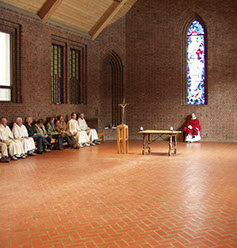













MONASTERY

Good Friday Service

Br. Benito Williamson
practicing lectio divina
Contemplation
defies simple definition
or explanation.
It is a state of being
and resting in God,
the mind passive,
open and empty of words and concepts,
listening to God who speaks in the silent depths
of the human heart.
HOW WE PRAY
MONASTIC PRAYER is both communal and individual. In his Rule, Benedict
emphasizes the importance of monastic prayer in common: “Nothing is to be
preferred to the Work of God [Liturgy of the Hours]” (Chapter 43), but he does
not discuss the method or structure of personal prayer. A description of prayer
in the monastic context, initiated by the Desert Fathers in the early formation of
monasticism, and developed over centuries of practice, follows.
SACRED READING [LECTIO DIVINA] is the expression first used by the 2nd century theologian Origen to describe the primary step in the monastic method of
meditation. Lectio divina is intentional concentrated attention on the Scriptural
reading in whole or in part, allowing the text to speak a word, phrase or idea
that seizes the emotions and stimulates the imagination. The twelfth-century
Carthusian monk Guigo II defines lectio divina simply as “the careful study of
the Scriptures, concentrating all one’s power [of thought] on it,” explaining it
metaphorically as the first rung on a ladder of consciousness climbing to
contemplation. Rather than reading to be informed, the reader reads to be
formed by the sacred text.
MEDITATION is conscious active engagement of the intellectual and rational
faculties of the mind to focus on the idea or image that in a moment of insight
has emerged from the sacred reading. Guigo II describes meditation as “the
busy application of the mind to seek with the help of one’s own reason the
knowledge of hidden truth.” The goal of meditation is to assimilate the depths
of the text’s meaning, applying it to the specific life situation of the one who
prays.
PRAYER is active “verbal” mental or oral response to meditation on the Word of
God, offered in a spontaneous, personal “conversation” with God. It is,
Cistercian monk Michael Casey writes, “an attempt to realize the love that
unites us to God, allowing it to become more present to us, and giving it greater
scope to act upon us and change us.” At this stage, affection and emotion
predominates with prayers of gratitude, repentance and adoration.
CONTEMPLATION defies simple definition or explanation. It is a state of being
and resting in God, the mind passive, open and empty of words and concepts,
listening to God who speaks in the silent depths of the human heart. As the
unknown medieval author of The Cloud of Unknowing wrote of those who seek
to move to the level of contemplative prayer: “Thought cannot comprehend
God…..You will seem to know and feel nothing except a naked intent toward
God in the depths of your being.” Words and thoughts are engulfed by
awareness of unity with the divine, “as an experiential grasp of God as present
within the inner self” (Thomas Merton). This overwhelming awareness of God’s
presence comes “like a flash of lightning” (John of the Cross), “like a clap of
thunder” (Thomas Merton). ✜
St. Benedict's Monastery | 1012 Monastery Road | Snowmass, Colorado 81654
970/279-4400 | EMAIL snowmasscoc@gmail.com